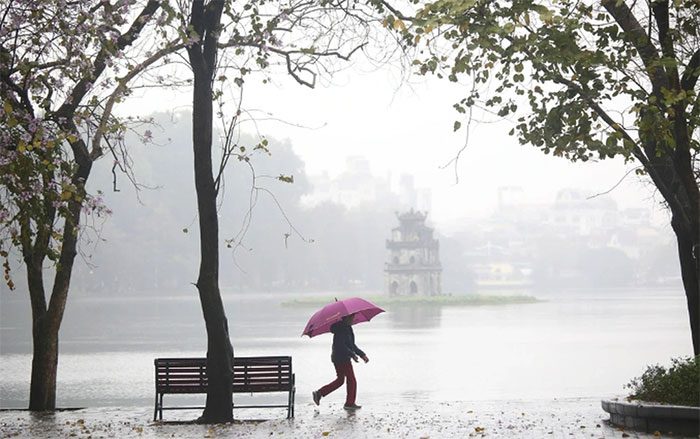The North Welcomes the Bân Cold. This is an unusual cold spell, occurring after several days of hot weather in the lunar March.
“January is cold, February is chilly, and March brings the Bân cold.” This proverb is familiar to many Vietnamese when discussing weather phenomena in the northern provinces during the early part of the year.

The Bân cold in the Northern region forces many to wear coats and knitted scarves when going out (Photo: Hữu Nghị).
Among these, the Bân cold is the most noteworthy phenomenon, primarily due to its unusual weather pattern that follows a period of hot days.
According to climate experts, this is essentially a late cold spell, influenced by cold air from the North that has spread down at the end of March and the beginning of April, when the weather had already warmed significantly.
Based on cloud charts from monitoring stations and measuring tools, it can be observed that during this time, cold air is still active, causing a mild cold spell that lasts no longer than 2-3 days.
However, because the overall temperature in the region is usually warmer, even after many days of hot weather compared to December, people tend to feel that the Bân cold is very cold.
The typical weather associated with the Bân cold often includes light rain and drizzles due to the late-season cold air not only moving from North to South but also slightly shifting to the East through the Gulf of Tonkin, bringing moisture from the sea.
During this time, temperatures can drop by 5-8 degrees Celsius, causing average temperatures to fall below 20 degrees Celsius. Additionally, in some areas, there may be heavy showers and thunderstorms, which can include tornadoes, hail, and strong gusts of wind.
Due to climate changes in Vietnam specifically and worldwide generally, the Bân cold does not occur every year, but there are years when it happens several times, with each spell lasting a few days.

The Bân cold brings mild cold weather, accompanied by light rain. (Photo: Hữu Nghị).
In Vietnam, the Bân cold has a certain impact on agricultural production because the timing of its occurrence coincides with the growth stage of crops, especially rice, which is in the flowering stage. The low temperatures can affect the normal development of rice plants, thereby impacting rice yields.
Moreover, sudden cold spells can affect the health of the elderly and young children, as their bodies may not adapt quickly enough. Hence, there is a saying: “In March’s cold, the elderly freeze to death.”




















































